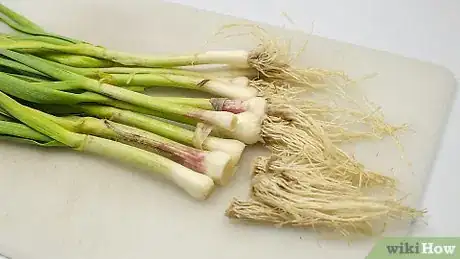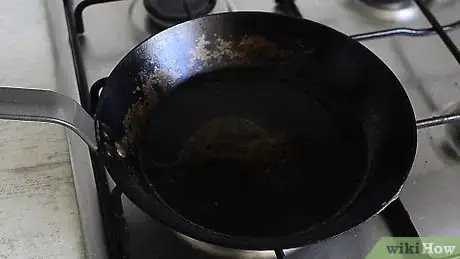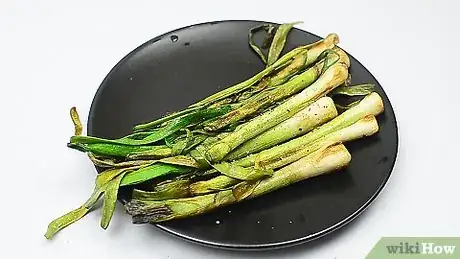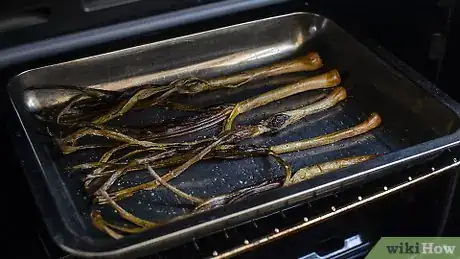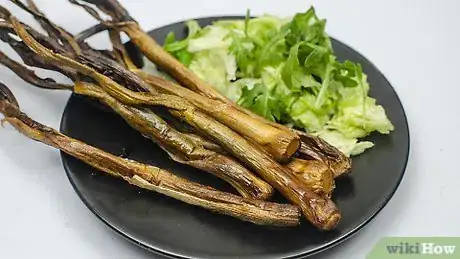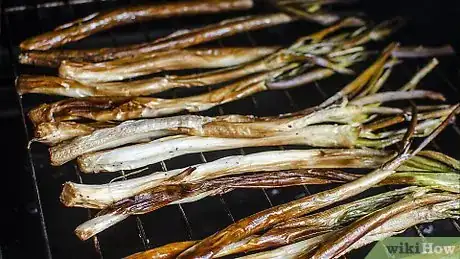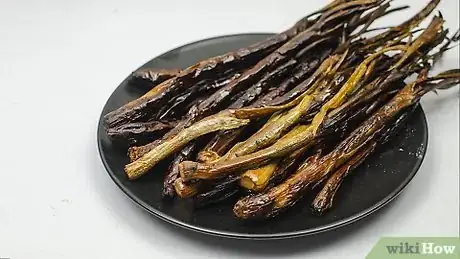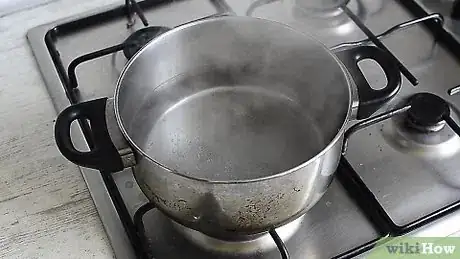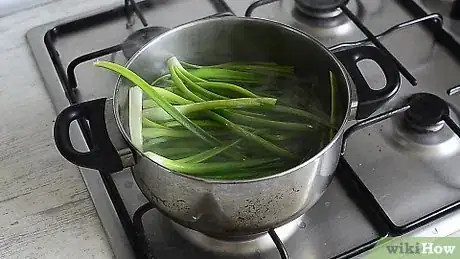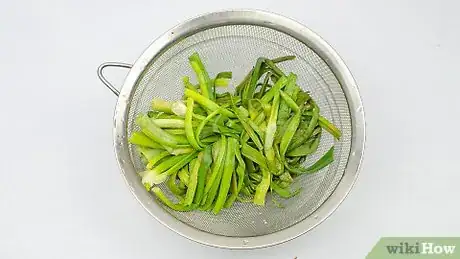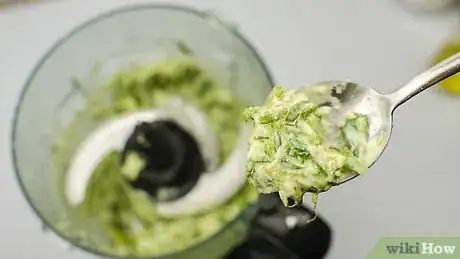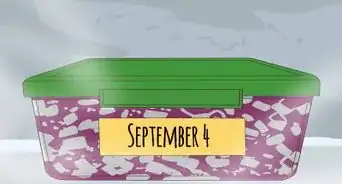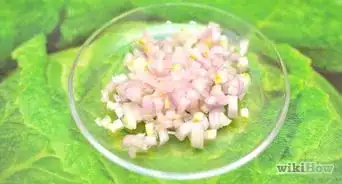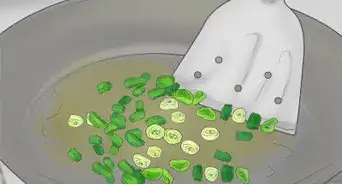This article was co-authored by wikiHow Staff. Our trained team of editors and researchers validate articles for accuracy and comprehensiveness. wikiHow's Content Management Team carefully monitors the work from our editorial staff to ensure that each article is backed by trusted research and meets our high quality standards.
The wikiHow Video Team also followed the article's instructions and verified that they work.
This article has been viewed 19,622 times.
Learn more...
With a pungent taste that balances hints of onion and garlic, ramps have become one of the most popular vegetables among foodies and experienced chefs. A type of wild onion, they are in season in the U.S. and Eastern Canada in the spring when you can find them at many farmer's markets. If you're not familiar with ramps, though, it can be difficult to know how to cook them. Fortunately, there are plenty of ways to use them in the kitchen. From sauteing to roasting to grilling, you can prepare them in a variety of ways as a tasty side dish or topping for your favorite meat. You can even turn them into a delicious pesto that you can toss with your favorite pasta or spread on a sandwich.
Ingredients
- ½ pound (227 g) ramps
- 2 teaspoons (10 ml) extra virgin olive oil
- Salt and pepper, to taste
- 10 to 15 whole ramps
- ¼ teaspoon (1 g) sea salt
- ¼ cup (59 ml) olive oil
- 32 ramps, cleaned and trimmed
- 2 tablespoons (30 ml) extra virgin olive oil, plus more for serving
- Kosher salt and freshly ground black pepper, to taste
- 3 garlic cloves, chopped
- ¼ cup (35 g) toasted pine nuts
- 3 tablespoons (15 g) grated pecorino romano cheese
- Leaves from 2 dozen ramps
- Salt, taste
- ½ cup (118 g) extra-virgin olive oil
Steps
Making Sauteed Ramps
-
1Trim and wash the ramps. For the sauteed ramps, you’ll need ½ pound (227 g) of ramps. To prepare them for cooking, use a sharp knife to cut off the roots. Next, run the ramps under cool water at the sink to remove any dirt or debris.
- To ensure that the ramps are dry, it’s a good idea to place them in a colander or sieve after you rinse them. Shake them well to remove any excess moisture.
-
2Separate the bulbs and the leaves. When the ramps are trimmed and cleaned, use the knife to separate the white bulbs from the green leaves. Leave the bulbs in tact, but cut the leaves in half or thirds horizontally.
- If any of the leaves appear tough or overly large, discard them. They are usually too chewy even after sauteing.
- If you notice any translucent skins, which are similar to those that you find on green onions or scallions, peel them away and discard.
Advertisement -
3Heat the oil. Place a nonstick skillet on the stove over medium-high heat. Add 2 teaspoons (10 ml) of extra virgin olive oil, and allow it to heat until it begins to shimmer, which should take 2 to 3 minutes.
- If you prefer, you can substitute butter for the olive oil.
-
4Add the white bulbs and cook them until translucent. When the oil is hot, add the white bulbs to the skillet. Allow them to cook for 2 minutes, or until they become translucent.
- Be sure to stir the bulbs occasionally to ensure that they cook evenly.
-
5Mix in the leaves and saute the mixture for another couple of minutes. Once the bulbs are translucent, add the ramp leaves to the skillet. Let them cook with the bulbs for another 2 minutes, or until the leaves begin to wilt.
- As with the bulbs, stir the leaves periodically as you saute them to ensure that they cook evenly.
-
6Season the ramps with salt and pepper and serve. When the ramp bulbs and leaves are finished cooking, stir in some salt and pepper to taste to season them. Place them in a serving bowl, and serve as a side with your favorite main course.
- If you prefer, you can add other seasonings to the ramp, such as chili powder or cumin.
- The sauteed ramps also make a delicious topping for sandwiches and pizza.
Making Roasted Ramps
-
1Preheat the oven. To ensure that the oven is hot enough to roast the ramps, it’s important to preheat it. Set the temperature to 375 degrees Fahrenheit (190 degrees Celsius), and allow it to fully heat.[1]
- Make sure that the oven rack is in the center position before you preheat it.
-
2Combine the ramps with olive oil and salt on a baking sheet. Place 10 to 15 whole ramps on a large metal baking sheet. Drizzle ¼ cup (59 ml) of olive oil and ¼ teaspoon (1 g) of sea salt over them, and toss well so the ramps are fully coated.[2]
- Be sure that the ramps are rinsed and trimmed before you toss them with the olive oil and salt.
-
3Bake the ramps until the leaves begin to char. Once the ramps are seasoned and coated with olive oil, place the baking sheet in the preheated oven. Allow the ramps to roast for 15 to 17 minutes, or until the leaves just begin to char.[3]
- You don’t want the ramps to actually burn. They’ll have a burnt toast taste if they do.
-
4Add the ramps to a salad, pasta dish, or sandwiches. When the ramps are finished roasting, remove the baking sheet from the oven. Mix the ramps into salads and pasta dishes, or use them as a topping for steaks and burgers.[4]
- Store leftover roasted ramps in an airtight container in the refrigerator. They should stay fresh for up to three days.
Making Grilled Ramps
-
1Toss the ramps with olive oil, salt, and pepper. Place 32 ramps that have been cleaned and trimmed on a large, rimmed baking sheet. Drizzle 2 tablespoons (30 ml) of extra virgin olive oil over them, and season them with kosher salt and freshly ground black pepper. Toss the mixture well so the ramps are well coated.[5]
- You can season the ramps with any other spices that you like, such as cumin or crushed red pepper.
-
2Preheat the grill. To ensure that the grill is hot enough for the ramps, it’s important to preheat it. Turn half of the burners on to the highest heat setting, and cover the grill. Allow it to heat for at least 10 minutes.[6]
- Make sure that the grilling grate is cleaned and oiled before you grill the ramps.
- If you’re using a charcoal grill, use one full chimney of lit charcoal but arrange the coals on only one side of the grill. Place the grill grate over them, and allow the grill to preheat for 5 minutes.
-
3Cook the ramps on the grill until they’re tender. When the grill is preheated, use tongs to place the ramps on the heated side of the grate. Let them cook until they become tender and slightly charred along the edges, which should take approximately 2 minutes.[7]
- Be sure to turn the ramps occasionally as you grill them to ensure that they cook evenly.
-
4Place the ramps on a serving platter and drizzle them with olive oil to serve. When the ramps are finished grilling, transfer them to a serving platter with tongs. Pour a little more olive oil over them and serve while they’re still warm.[8]
- Grilled ramp make a delicious side for any meat that you’ve grilled.
- They are also a tasty topping for burgers and steaks.
Preparing Ramp Pesto
-
1Bring a pot of salted water to boil. Fill a large pot approximately ⅔’s full with water. Season the water with salt, and place it on the stove on high heat. Allow the water to come to a full boil.[9]
- You should add enough salt to the water so it tastes like sea water.
-
2Add the ramp leaves and boil quickly. For the pesto, you’ll need the leaves from 2 dozen ramps. When the water has come to a boil, add them to the pot and allow them to boil for 1 minute.[10]
-
3Transfer the leaves to cold water. Once the ramp leaves have boiled for a minute, remove them from the pot with a slotted spoon. Immediately dump them into a boil of ice water to stop the cooking process. Let the leaves sit in the water until they are cooled. [11]
- Make sure to set up the bowl of ice water beside the stove before you begin boiling the ramp leaves, so you can transfer them to it right after boiling.
-
4Strain the leaves in a colander and dry them thoroughly. After you’ve dropped the ramp leaves into the ice water bath, transfer them to a colander. Shake the leaves well to remove the excess moisture, and then squeeze them with paper towel so they’re as dry as possible.[12]
- You can use a tea towel to dry the ramp leaves if you prefer.
-
5Chop the ramp leaves. After you’ve dried the ramp leaves, use a sharp knife to chop them. They don’t need to be finely chopped, though, because they’ll be shredded further in the food processor.[13]
-
6Pulse the pine nuts and garlic in a food processor. To begin the pesto, add 3 roughly chopped garlic cloves and ¼ cup (35 g) of toasted pine nuts to the bowl of a food processor. Pulse the mixture until the ingredients are finely crushed.[14]
- If you don’t have a food processor, you can use a blender or mortar and pestle to make the pesto.
-
7Mix in the cheese and ramps. Once the garlic and nuts are crushed, add 3 tablespoons (15 g) of grated pecorino romano cheese and the chopped ramp leaves to food processor. Pulse the mixture until the leaves are fully chopped and the mixture is completely blended.[15]
- You can substitute parmesan or asiago cheese for the pecorino romano.
-
8Add the oil a tablespoon at a time until the pesto reaches the proper consistency. When the nuts, garlic, cheese, and ramp leaves are combined, start streaming up to ½ cup (118 g) of extra-virgin olive oil into the mixture as you pulse the food processor. Continue mixing the pesto until it reaches your desired consistency.[16]
- The proper amount of oil depends on the consistency you want for the pesto. If you plan to use it as a spread, add less oil. If you are using it as a sauce, add more oil.
-
9Taste the pesto and season if necessary before using. When you’re finished mixing the pesto, give it a taste. The cheese often adds enough salt, but if the seasoning is lacking, stir in some salt and/or pepper before using or serving the pesto.[17]
- Ramp pesto makes a delicious pasta sauce, but you can also use it as a spread for sandwiches and bread.
- You may also want to mix the ramp pesto into your favorite soup recipe or use it top fish or poultry dishes.
- Store any leftover pesto in an airtight container in the refrigerator with a layer of olive oil poured over the top. It should keep for 5 to 7 days.
Things You’ll Need
Sauteed Ramps
- Knife
- Colander
- Nonstick skillet
- Wooden spoon
Roasted Ramps
- Large baking sheet
- Tongs
Grilled Ramps
- Large, rimmed baking sheet
- Tongs
- Grill
Ramp Pesto
- Large pot
- Large bowl
- Colander
- Paper towel
- Knife
- Food processor
References
- ↑ https://ally-jane.com/2013/04/30/roasted-ramps/
- ↑ https://ally-jane.com/2013/04/30/roasted-ramps/
- ↑ https://ally-jane.com/2013/04/30/roasted-ramps/
- ↑ https://ally-jane.com/2013/04/30/roasted-ramps/
- ↑ http://www.seriouseats.com/recipes/2013/05/grilled-ramps-recipe.html
- ↑ http://www.seriouseats.com/recipes/2013/05/grilled-ramps-recipe.html
- ↑ http://www.seriouseats.com/recipes/2013/05/grilled-ramps-recipe.html
- ↑ http://www.seriouseats.com/recipes/2013/05/grilled-ramps-recipe.html
- ↑ http://honest-food.net/ramp-pesto/
